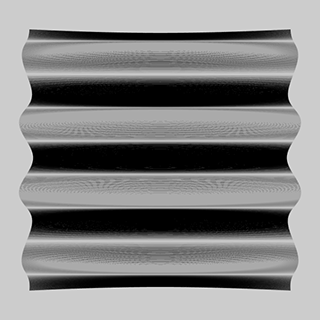Simple sine waves applied to the vertical and horizontal axes were used to generate a static base form:
The forms are projected in perspective with the amplitude of a sine wave modulating the z axis depth in space. When the two are added together they make:
Fourier series triangle wave functions applied to the horizontal and vertical axes, and added together make:
Using a different frequency there are four times as many triangle waves as there were sine waves. Combining all four functions, two sine and two triangle Fourier series waves, makes:
Animating the composite form by moving the triangle waves across the static sine waves makes the final gif, top.
For simplification, two of the four functions that are combined in this example are just sine waves. The other two Fourier series functions are only a few sine functions, sufficient to create a suitable triangle wave.
This example, as well as each surface in Fourier Series, & Rectify could be used to model physical surfaces.







